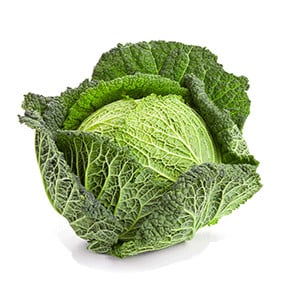Cabbage (Savoy cabbage)

Cabbage (Savoy cabbage)
Brassica oleracea convar. capitata var. sabauda
Plant family
Crucifers (Brassicaceae)
Cultivation Break
3 Years
Season Overview
Propagating
Planting
Harvest
J
F
M
A
M
J
J
A
S
O
N
D
Details
Light requirement
Semi-shaded
Water requirement
Moist
Soil
Medium (loamy)
Nutrient requirement
High
Plant distance
50 cm
Row spacing
75 cm
Seeding depth
2 cm
Instructions
The season for this plant is over. The following instructions are for the next season.
End of March
Propagating
Beginning of April
Pest protection
Every week
Beginning of April
Transplanting
Description
Savoy cabbage is a special type of head cabbage and a cultivated form of vegetable cabbage. It is characterized by curly leaves.
Origin:
Savoy cabbage originates from the Mediterranean region, probably from northern Italy.
Growing tips
In general, there are three different types of savoy varieties: early, medium and late maturity. Savoy cabbage is suitable for both preplanting and direct sowing. Early varieties of savoy cabbage should be sown as early as February. For this purpose, a bright windowsill or a greenhouse is suitable. For medium varieties, May is best for planting or sowing. Late varieties can be sown from July onwards. Most later varieties of savoy cabbage can also overwinter outdoors without problems. If there is still a risk of night frost when planting the early varieties, you can remedy the situation by covering them with garden fleece. Sunny beds are preferred, but semi-shaded places are also perfectly adequate. If your soil is sandy, you can amend the soil with compost and horn shavings before planting. During the growth phase, you should loosen the soil around the plant from time to time with a hoe. Since Savoy cabbage is a so-called root crop, it will thank you for the regular loosening of the soil. Savoy cabbage is generally a grateful comrade for the hobby garden, because it is very low-maintenance and can be grown quite easily in your own bed. Too much fertilization leads to reduced resistance to diseases and a sulfurous taste. Furthermore, the shelf life also suffers quite a bit. When growing Savoy cabbage on the same area, you should - as with all types of cabbage - take a four-year break from cultivation.
Companion Plants
Artichoke
Aubergine / Eggplant
Bean (Broad bean / Faba bean / Field bean)
Bean (Dwarf bean)
Bean (Runner bean)
Beetroot
Black salsify
Borage
Caraway / Meridian fennel / Persian cumin
Carrots
Celery (Celeriac / Celery root)
Celery (Celery)
Chamomile
Chard
Chili
Common marigold
Coriander / Cilantro
Cucumber / Gherkin
Dill
Leeks
Lettuce (Endive / Escarole / Erisée)
Lettuce (Lamb's lettuce)
Lettuce (Lettuce)
Lettuce (Radicchio / Italian chicory)
Mint
Oregano
Parsnip
Pea
Pepper / Paprika
Potato
Radish
Radishes
Rhubarb
Sage
Soybean
Spinach (Summer)
Thyme
Antagonistic Plants
Arugula / Rocket
Broccoli
Brussels sprouts
Cabbage (Cabbage)
Cauliflower
Chives
Collard greens (Kale)
Collard greens (Tuscan kale / Dinosaur kale / Palm tree kale)
Fennel
Florence fennel / Finocchio
Jerusalem artichoke / Topinambur
Kohlrabi / German turnip / Turnip cabbage
Lentils
Lovage
Marjoram
Mizuna / Japanese mustard greens
Napa cabbage / Chinese cabbage
Onion
Onion (Spring onion)
Pak Choi
Rutabaga / Swedish turnip
Strawberry
Turnip
Diseases
Club root of cabbage
Pests
Cabbage white
Flea beetles
Cabbage fly
White fly